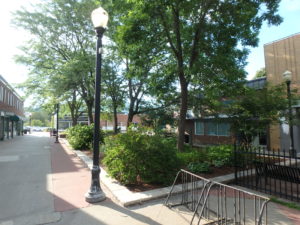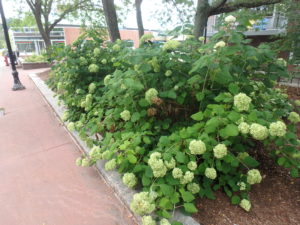Growing Flowers in Shade with Root Competition
Folks who only have shade often give up on gardening because they cannot grow things like poppies and peonies, and only know “boring” shade plants planted for their foliage rather than their blossoms: hostas, pachysandra and myrtle. But even those plants don’t necessarily grow vigorously in shade. More often the not, the problem is not shade, but root competition.
Ten years ago my partner, Cindy Heath and I accepted the task of designing and installing a garden for the city of Lebanon, NH on the mall near two nice restaurants. The space is 30 feet wide and 60 feet long. When I took on the job it had 3 locust trees and 2 green ash trees which kept most of the potential garden in shade. The soil was covered with 3-4 inches of bark mulch, many weeds, and half a dozen hostas. We got the city to remove one tree, so there are sunny places now.
When I dug into the bark mulch I found roots from the trees everywhere; when I dug into the soil I found gravel, sand, bricks and rubble. Not a place conducive to gardening – even the weeds were struggling and undersized. Anything planted in the space would be competing with the trees for both minerals and water.
So here is what we did: we had good soil and compost brought in and spread out everywhere – 3 or 4 inches deep. We covered the mulched wood chips with soil to break down over time, adding much needed organic matter.
Next we built berms: mounds of soil and compost 8-12 inches deep arranged in large beds with curved lines. The tree roots eventually migrated into these “root free zones”, but by then the plants there had established themselves and were better able to compete with the tree roots.
At planting time we added plenty of slow release fertilizer and mineral supplements. I used a slow-release organic fertilizer, along with green sand and rock phosphate.
Green sand is a natural soil supplement that increases potassium levels and adds many micronutrients from the sea, where it formed millennia ago. It promotes strong cell walls, which helps plants withstand drought, heat and cold.
The rock phosphate, which is a finely ground rock containing significant quantities of slow-breakdown phosphorus-containing minerals, will not wash away and breaks down over a multi-year period. It promotes good root growth and flowering.
We top-dressed the plants most years with extra fertilizer and minerals, knowing that they are competing with the tree roots. A local volunteer waters during dry times, which helps a lot.
What did we plant? We had been given hostas and daylilies by local citizens, along with a few irises. I timed the sun traveling across the sky and saw there were places that got 6 hours of sun – enough for the daylilies, iris and few annuals. New Guinea impatiens and impatiens have done well most years, and in the sunnier spots zinnias, marigolds and cleome are welcome color.
What plants have thrived, now 10 years later? Hostas did great. European wild ginger (Asarum europaeum), with its glossy green leaves has thrived, forming big clumps. We planted a small patch of snakeroot (formerly Cimicifuga racemosa, now Actea racemosa) that has done fabulously, with flower stalks standing 5 feet tall with white, bottle-brush, fragrant flowers. It has spread to fill in its bed nicely.
Bigroot geranium (Geranium macrorrhizum) has done fine, with spring flowers and nice leaves all summer long. I also planted fringed bleeding heart (Dicentra exemia), which also did fine.
What disappeared or failed to thrive? A ground cover known as spotted dead nettle (Lamium maculatum). Normally dead nettle thrives in shade, but the root competition was too great, and it is virtually gone. Also almost gone now is lungwort (Pulmonaria officinalis), another shade stalwart. Coral bells (Heuchera spp.), which does well in shade elsewhere, did not survive. Daylilies, even those tough common orange ones, have survived – but have not thrived.
We also planted a few tough shrubs, and all have done well: a Miss Kim lilac, 2 shad bushes (Amelanchier spp.) and a pair of hydrangeas (Hydrangea arborescens), a variety called ‘Hills of Snow’. This has smaller blossoms than the popular ‘Annabelle’, but does well in shade and the small flowers do not flop so much on rainy days. When planting the shrubs I dug extra wide holes to keep the existing tree roots at bay a little longer. We cut back any tree roots we found at planting time.
So don’t despair if you lack a nice sunny spot for flowers. Even in dry shade you can have flowers – but you may have to try several to find just the right ones for your situation.
I am hoping to help lead a Viking River Cruise next June from Paris to Normandy and back with stops along the way – including Monet’s magical garden, Giverny. If there is enough interest, we might have 3 days in Paris looking at gardens there. If you are interested, e-mail me at henry.homeyer@comcast.net.





